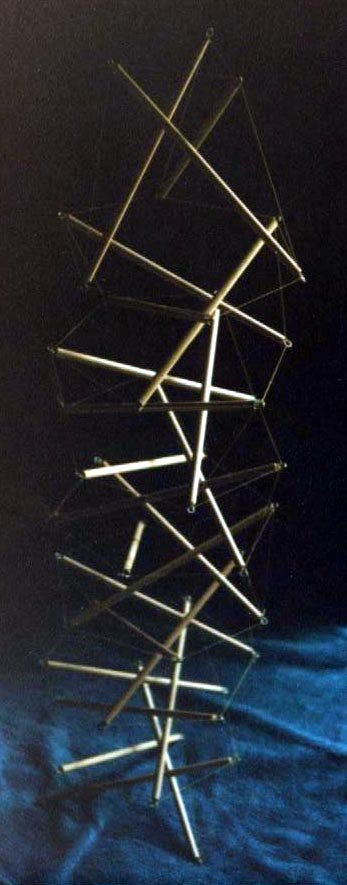

On June 10 and 13, 1981, I designed and built my first tensegrity mast. This seems to be a rite of passage for many tensegrity enthusiasts. Hugh Kenner's exploration of tensegrity prisms in his book Geodesic Math and How to Use It (recently -- 2003 -- reissued by the University of California Press!) was the prime impetus. This mast is based on the tensegrity prism. The top and bottom of the mast are tendon triangles as in a three-fold prism; the intermediate layers are tendon hexagons. Struts interconnect the layers. The intermediate layers are interfaces where two tensegrity prisms are connected. The struts are all the same length, although the perspective effect of the photo somewhat belies this.
I took care in the articulation of the stories so they all spiraled in the same direction, and this created a beautiful effect to my mind. The mast was very jiggly, and I thought this gave it less promise as a practical structure. That jiggling seemed to weigh more on my mind that its beauty and the geometric insight that went into it.
I later found the same construction in David Georges Emmerich's book, Structures Tendues et Autotendantes (Paris, France: Ecole d'Architecture de Paris la Villette, 1988), where he does a lot of other things with prisms and agglomerations thereof. He calls it a "māt antiprismatique monogyre" (anti-prism-based spiral mast, p. 200). Since he seems to have thought of it first, I'll call it a mast. A similar structure, with prisms that alternate in sense rather than "monogyre" (spiraling) as above, appears as Fig. 5 in his French Patent No. 1377291. This mast isn't completely "monogyre" since the top stage spirals in the opposite sense from the other stages.
Structures Tendues et Autotendantes (Prestressed Tensile Structures) is a magnificent inventory of tensegrity structures. It doesn't always indicate who invented what, and I know there are some things in the inventory that aren't Emmerich's, the tensegrity icosahedron for example. I wish someone with access to the original typescript would reissue this book with better reproductions of the photographs. For a scholarly work of this magnitude and value, the photographic reproductions are abysmal. Maybe that's just MIT's copy.
I think Maxim Schrogin's arch must have looked like this mast before he bent it over to make the arch. The layers on this structure are broader (longer strut relative to side tendon lengths). This structure was designed so that, except for the three base tendons and the three side tendons at the top, all the tendons are equal in length.
A similar structure, completely monogyre and with all the tendon lengths equal (which therefore means the bottom and top struts are shorter than the rest), is available in the tensegrity viewers as "Bouncy Mast (spiraling)". There is also an alternating version available there.
With this mast fresh in mind, on November 21, 2005, I designed a twelve-stage torus in this style. It's simpler to assemble than other tori I've designed and might make a good holiday wreath. The torus/wreath is available as a VRML Model and in the Java-based viewers (choose the "Twelve-Stage Torus" in the latter). A 24-stage version of this torus appears in Emmerich's book as a "tore juxtapose hexagonal antiprismatique" (p. 260). "juxtapose" (or sometimes "racemique") is the antonym of "monogyre" meaning the prisms alternate in sense as one goes around. This contrasts with the spiral effect created by keeping the same sense from stage to stage as in the mast above.


